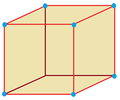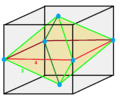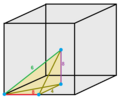Top Qs
Timeline
Chat
Perspective
Architectonic and catoptric tessellation
Uniform Euclidean 3D tessellations and their duals From Wikipedia, the free encyclopedia
Remove ads
In geometry, John Horton Conway defines architectonic and catoptric tessellations as the uniform tessellations (or honeycombs) of Euclidean 3-space with prime space groups and their duals, as three-dimensional analogue of the Platonic, Archimedean, and Catalan tiling of the plane. The singular vertex figure of an architectonic tessellation is the dual of the cell of the corresponding catoptric tessellation, and vice versa. The cubille is the only Platonic (regular) tessellation of 3-space, and is self-dual. There are other uniform honeycombs constructed as gyrations or prismatic stacks (and their duals) which are excluded from these categories.

Remove ads
Enumeration
Summarize
Perspective
The pairs of architectonic and catoptric tessellations are listed below with their symmetry group. These tessellations only represent four symmetry space groups, and also all within the cubic crystal system. Many of these tessellations can be defined in multiple symmetry groups, so in each case the highest symmetry is expressed.
Remove ads
Vertex Figures
The vertex figures of all architectonic honeycombs, and the dual cells of all catoptric honeycombs are shown below, at the same scale and the same orientation:
Symmetry

These four symmetry groups are labeled as:
References
Further reading
Wikiwand - on
Seamless Wikipedia browsing. On steroids.
Remove ads





























